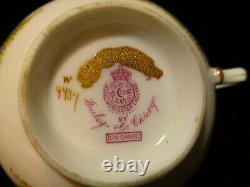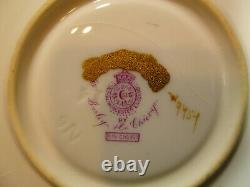Kansas City History Signed Set Of Royal Worcester Cups & Saucers Circa 1912













KANSAS CITY HISTORY: SIGNED 12 PIECE SET OF ROYAL WORCESTER INDIAN TREE CUPS & SAUCERS FURNISHED EXCLUSIVELY FOR THE HOTEL MUEHLEBACH - CIRCA 1912. Each three-part cup and saucer set (there are three complete sets) stands approximately 2 ¼ high. The saucer measures approximately 5 ¼ in diameter and the under plate measures approximately 8 in diameter.
Each cup measures approximately 3 1/8 in diameter at the top. The set is in good condition with a few exceptions. Under plates (4) there are no chips or cracks to any of the under plates. There are surface scratches to the white central part of each plate as they were obviously used by hotel guests. There are a few areas of wear to the paint.
Saucers (3) there are no chips to any of the saucers. One of the saucers has a very faint hairline crack. Surface scratches in the center of each saucer and minor loss of some paint. Cups (5) none of the cups has any chips. Three of the cups are in excellent condition and have no chips or cracks.
Two of the cups have cracks. Each of the 12 pieces is signed on the underside with the purple Royal Worcester mark. There are words that have been covered over with gold glittery paint and I can see enough of the letters under the paint to see that they read. Furnished Expressly for Hotel Muehlebach. Kansas City natives and residents, this set is a piece of local history and a wonderful slice of memory lane as the set was originally furnished to the Hotel Muehlebach.The registered number on the cups and saucers indicates that the Indian Tree design used on these cups and saucers was registered in 1912. The Royal Worcester mark tells us that these pieces were made in 1912. About the Hotel Muehlebach from an article in the Kansas City Star on April 20, 2015.
When the Hotel Muehlebach first opened its doors in 1915 it was a sight to behold. It was a palace, no doubt, and throughout much of the 1900s, it would evolve into what might very well have been the citys social epicenter, hosting a seemingly endless carousel of presidents, athletes, writers and actors. Inside its walls, a centurys worth of history played out.Love, life, death and, yes, even a ghost story or two. Today, still standing among the surrounding skyscrapers yet closed for all but group gatherings, it serves as a kind of hidden jewel for those who know what theyre looking for. Now part of the Kansas City Marriott Downtown complex, it is a relic, a reminder of an older, grander time, when a hotel was more than just a place to rest your head between flights.
As Cynthia Savage, vice president of the Raphael Hotel Group and daughter of the late hotelier and onetime Muehlebach general manager Philip Pistilli, puts it: There probably arent very many buildings in Kansas City that have seen the things this building has. It started as a place of worship. Acquired by the Muehlebach Estate Co. In 1914, the land at 12th and Baltimore streets in downtown Kansas City was home to the old First Baptist Church.Muehlebach whose father had built a local empire through farming, real estate and the operation of a vineyard and brewery had other plans. He promptly had the church demolished to pave the way for the construction of a 500-room hotel that would serve as a pillar of Kansas City social life. Even before its completion in May 1915, the hotel had piqued the citys imagination.
When it was announced that a grand opening celebration would be held in two of the Muehlebachs dining areas, 1,200 applications poured in for the 800 available seats. Everything about the place oozed elegance. The lobby, with its blend of Southern and English Colonial feeling.
Troves of fancy furniture with an Elizabethian theme. The mere breadth of the offerings: a banquet hall, multiple restaurants, a tea room, a ballroom, a music room, a drawing room. And it wasnt just the decor.Whitmore rounded up a collection of established hotel royalty: The manager, Joseph Reichle, had previously worked for the Waldorf in New York City and the Ritz in London, while the room clerks had come from the well-regarded Alexandria and Utah hotels in Los Angeles. Even the help was selected with attention to detail. Whitmore boasted to The Star at the time that many of the hotels waiters could speak four to six languages. It didnt take long, meanwhile, for its reputation to stretch past the citys downtown corridor. 5, 1922, just seven years after the hotel had opened, history was made inside the Plantation Grill when Carleton Coon and Joe Sanders aired what would come to be considered the first regular radio program performed by a band.
The lack of radio stations at the time allowed their show to reach much farther than it would today, and the nightly performances of the Coon-Sanders Nighthawks Orchestra could be heard across the country and even, on occasion, overseas. Letters and telegraphs poured in, prompting the band to form its own fan club and thus expanding the Muehlebachs already considerable reputation. The Muehlebach was always the spot, it was always the place, said Chuck Haddix, sound and recording specialist with the University of Missouri-Kansas City Marr Sound Archives, who has been researching the Coon-Sanders band, including its time broadcasting from the hotel. Things progressed well over the course of the decade, as the hotel became increasingly ingrained in the downtown fabric.Then the stock market crashed, and as the roaring 20s gave way to the Great Depression of the 1930s and financial struggles besieged the city and nation, it seemed fair to wonder whether the Muehlebach would succumb to the pressures facing countless others. And it might have, if not for a pint-sized man who would usher the hotel into its most prosperous era.
Barney Allis was a perfectionist, a tough little cuss who stood just 5 feet 3 and ran the hotel with something of an iron fist. He had taken over as manager of the Muehlebach in 1931, after a stint running the nearby Baltimore Hotel, and it hadnt taken long for him to make his presence known. His demanding expectations for employees became something of local legend; hed wake them at all hours, even urging them, according to a long-ago story in The Star, not to golf in their free time.
Once, when he noticed an elevator operator had failed to fasten a button on his tunic, he is said to have walked over, ripped the mans tunic apart, and then strolled away without a word. Today, we might describe Allis as a case study in the particulars of the Napoleonic complex. But he was also a visionary, and as his tenure at the Muehlebach advanced, so, too, did the hotels reputation. In his capacity as the hotels proprietor, Allis welcomed some of the eras biggest names to Kansas City, from Helen Keller to Ernest Hemingway. The latter was said to have occasionally slept in a hotel bathtub during his time as a reporter with The Star.So regular were the high-profile visitors that the hotel developed a code word for guests who warranted special attention. Promptos, they were called, and in those days, as the Depression fell further and further from memory, the hotel welcomed scores of them.
Over the years, various presidents would rest their heads upon Muehlebach pillows among them, Theodore Roosevelt, Woodrow Wilson, Calvin Coolidge and Herbert Hoover and Harry S. Trumans presence in the hotels Presidential Suite would become so ubiquitous that the Muehlebach came to be known as White House West. And it wasnt just visiting royalty. For decades, Kansas Citians flocked to the hotels lavish ballrooms, restaurants and bars for various social gatherings and business meetings. There were dinners and parties and banquets, wedding receptions and committee get-togethers. It really was the dominant place for people to meet and socialize and do business, said former Kansas City Mayor Richard Berkley, who later would occasionally conduct meetings there during his time in office. It just was the center of activity in the downtown area, it was just a focal point.Under Allis, the hotel seemed to take on almost a life of its own, the kind of place that gave way to a collection of oft-repeated if unverified anecdotes. In one, Allis, having been assured by a hotel manager that everything in the lobby was in order, proceeded to ask why, then, a dead man was currently seated there, having gone unnoticed.
In another Muehlebach tale, a hotel employee was said to have seen the typically disheveled Howard Hughes standing in the hotel lobby and figuring him to be a man who had wandered in off the streets had him promptly removed from the building. And then, of course, theres the legend of the Blue Lady a blonde-haired, 30-something apparition who allegedly stalked the hotel grounds, in search of a lost lover. By the early 1960s, however, Allis had had his fill. Never die in your own hotel, he had always said. Three months after the sale, Allis dropped dead in front of the Aladdin Hotel, just down the street from the Muehlebach.
The hotel would never be the same. Kansas City underwent significant change in the latter part of the 20th century, and that spelled trouble for the Muehlebach. Other, newer hotels began to pop up, each one, it seemed, nicer and fancier than the last. Stand-alone restaurants and bars became increasingly en vogue. Westport and the Plaza emerged as the citys de facto social hubs, as downtown foot traffic began to thin out during the 70s and 80s.
The Muehlebachs role as the citys social hub, in effect, had diminished. But the Muehlebachs memory is carried on by the few still living who experienced the hotel in its heyday. Regina Pachter remembers the majesty of the Muehlebach during its glory days, and on a recent weekday afternoon inside her home, she smiled as she recalled the hotel she once frequented with her late husband. Now 99 years old, Pachter was a regular at the hotel during the 40s. She attended banquets and parties.
She co-chaired an organization with Barney Allis wife. Once, she played the piano at the Muehlebach. You felt like you were being treated like royalty, she said of her experiences at the hotel.Years ago, when he was a college student at Penn Valley junior college, he worked an internship at the front desk of the Muehlebach, and he never did forget the experience. Not long ago, his daughters wedding reception was held in the old Muehlebach lobby, and Mayo spent the occasion proudly telling guests that hed once worked behind the front desk, which, during the reception, served as the bar. During a career that has been dedicated to hotels hes now general manager at the Hilton Garden Inn in Kansas City, Kan. Mayo has maintained a long-standing connection to the Muehlebach. Though it had already begun to lose some of its prominence by the time he arrived at the hotel in the early 70s, there was no questioning its reputation as a city landmark.
Even though it was struggling a bit, Mayo said, it was still the granddaddy hotel. At the moment, the hallways and lobby of the granddaddy are mostly empty, save for an occasional passerby. Its a recent weekday afternoon, and Savage and downtown Marriott general manager Rusty Macy are giving a tour of the original building. Though some areas have been renovated, many of the historic spaces inside the Muehlebach have been restored to maintain their original look. The old-fashioned lobby, complete with key-slots behind the front desk.The old bar on Baltimore, its old wooden floors still intact. And while its upper floors featuring roughly 150 rooms worth of floor space are no longer in use and havent been since 1986 events are still regularly held in the hotels public spaces: meetings, conventions, wedding receptions. Today, its the nearby Marriott that attracts the business kings and convention crowds. With 983 guestrooms and roughly 93,000 square feet of event space, as well as a new, modern lobby, the Marriott complex is a go-to convention hotel, as well as the lodging of choice for various visiting celebrities and entertainers. Still, theres no denying the Muehlebachs importance.
The Muehlebach has been a jewel to the city and to the hotel industry, said Bud Nicol, executive director of the Hotel and Lodging Association of Greater Kansas City whose office wall is adorned with a posterized tribute to the Muehlebach. To Savage, it holds a special significance; her father, Philip Pistilli, first went to work at the Muehlebach in 1954 as a Barney Allis protege, and the daughter still remembers coming to the hotel as a child, along with brother Kevin Pistilli, when her father was running the place. On those occasions when she gives a tour of the hotel grounds to interested guests, Savage said, she still notices their eyes light up when they arrive at the old Muehlebach.
Currently, there are no plans to reopen the buildings guestrooms though Savage doesnt rule it out at some point. And while restoration of a historic hotel may be desirable, it doesnt solve the citys need for a marquee convention hotel. Mayor Sly James told his City Council colleagues at a discussion in January that the city needs a new convention headquarters hotel with 800 to 1,000 rooms. We need a hotel that has been built since 1985, he said. If were going to compete with the big boys, we need to be the big boys, too. Downtown has made a resurgence recently. With the construction of the Sprint Center and the Power & Light District. The citys streetcar project, expected to debut in 2016, figures to be another step forward. Yet, even as time moves forward, there remains a focus on maintaining the essence of a building that has been as much a part of the citys fabric as any other in the citys history. We look now at all the improvements we make, and theyre for the future, Savage said. But theres still a way to preserve the history. The item "KANSAS CITY HISTORY SIGNED SET OF ROYAL WORCESTER CUPS & SAUCERS CIRCA 1912" is in sale since Saturday, April 6, 2019.This item is in the category "Antiques\Decorative Arts\Ceramics & Porcelain\Cups & Saucers". The seller is "davidgrant777" and is located in Lake Oswego, Oregon.
This item can be shipped worldwide.
- Style: Chinoiserie
- Age: 1900-1940
- Maker: Royal Worcester
- Original/Reproduction: Antique Original
- Type: Cup & Saucer Set
- Color: Multi-Color
- Country/Region of Origin: United Kingdom

